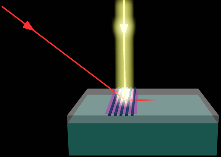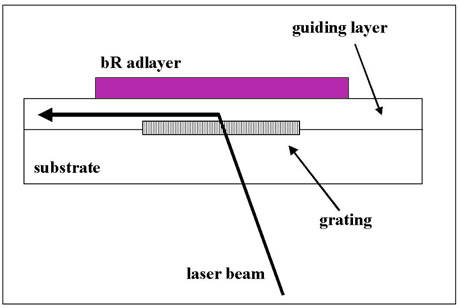
NATO SCP programme
Opto-electronic devices
based on bR
Since the start of integrated electronics the expansion of development has been described by “Moore’s law”: the density (performance) of integrated electronic circuits doubles about every 1.8 years. While this “law” has remained proven valid for a remarkable period of 30 years, there is a general perception that an evolutionary breakpoint has been reached. It is agreed that future development needs revolutionary new principles.
A plan has been presented to introduce a promising new technology in opto-electronics based on the chromoprotein bacteriorhodopsin. The development is focused on two areas: optical data processing and sensor technology.
Coupling of optical data-processing devices with microelectronics, as well as with sensory functions, is one of the biggest challenges in modern molecular electronics. Intensive research is going on to seek the most suitable nonlinear optical (NLO) materials, that could meet the demanding requirements (high sensitivity and stability) of applications. The favourable properties of NLO materials that manipulate light by changing their refractive index and other properties under the influence of an applied voltage or another light beam, can be utilised in integrated optical devices (IOD).
Bacteriorhodopsin as an NLO material
As far as sensory function is concerned, NLO materials of biological origin (e.g. enzymes, chromophores or chromoproteins) are among the most promising candidates, because of their extreme sensitivity and specificity. Several biological molecules are under consideration for use in future computer hardware, but the bacterial chromoprotein, bacteriorhodopsin (bR) has generated the most interest. BR, isolated from the outer cell membrane of the salt-loving bacterium, Halobacterium salinarium, is the simplest known ion pump in biological systems, and one of the best-characterized membrane proteins. When irradiated with visible light it transports protons across the membrane, while undergoing a cyclic reaction series of quasi-stable intermediate states ("photocycle").
Following light excitation during the photocycle the bacteriorhodopsin molecule changes its optical absorption, refractive index and charge distribution. These properties can be used separately or simultaneously in opto-electronic devices. Gels and thin films containing oriented bR molecules are extremely stable, they maintain their photoelectric activity at the same level for several years. On the other hand, the photocycle of bR can be controlled in many different ways. For example, the population states of the intermediates can be manipulated by a combination of orange and blue light illumination in situ, while genetic engineering techniques make special site-directed mutant bR-s with drastically altered optical properties and photocycle kinetics available.
Due to these remarkable and modifiable properties bacteriorhodopsin can be regarded as a programmable protein.
Optical waveguides and bacteriorhodopsin
The fundamental element of integrated optical devices is the optical waveguide. Here, on top of a glass substrate a thin (~200 nm thick) layer of a material of very high (~2) index of refraction is acting as an optical waveguide. Light is coupled into the waveguide by a diffraction grating formed at the interface of the waveguide layer.

The geometrical conditions for effective coupling are very strict: only light coming at a very well defined angle with respect to the grating is coupled into the waveguide. The corresponding theory is well understood: the angle at which coupling takes place largely depends on the refractive index of the material around the grating. This phenomenon is the basis of the applications of NLO materials: by changing the refractive index the coupling (in and out) can be arbitrarily modulated. Thus, optical switching can be established.
In the case of a bR adlayer, the refractive index changes are associated with intermediate transitions during the photocycle. The figure below visualizes the coupled intensity change corresponding to the transition from the BR groundstate to the M intermediate:
